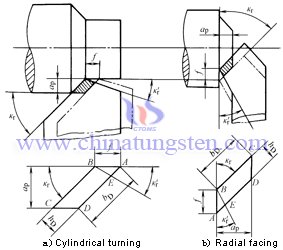Cemented Carbide Tools Cutting Layer & Mode
Cemented carbide cutting tools cutting layer parameters
Cutting layer of the cemented carbide cutting tools is the workpiece material layer to cut through the removal of the workpiece in a single pass of to the cutting portion. Cutting layer shape, size directly affects the deformation of the cutting process, the tool bear the load as well as the cemented carbide cutting tool wear. As shown, when the main and auxiliary cutting edges is straight, and λs = O °, KR> 0 °, the cutting layer to the nominal cross section ABCD is a parallelogram, if Kr = 90 °, or rectangular.
| Cemented Carbide Cutting Tools Cutting Layer Parameters |
 |
cemented carbide cutting tools cutting layer size refers metric length and width of the cutting layer in a cemented carbide cutting tool base surface, which is related to the cutting parameters ap, ƒ size. However, the direct impact of the cutting process is a cross-sectional view of the cutting layer, and its thickness, the width dimension. Their definitions and symbols are as follows:
1.A cutting layer public said cross-sectional area AD: referred to as the cross-sectional area of the cutting layer and it is a measure of the cross-sectional area in the plane of the cutting layer size.
2.Cutting nominal thickness BD: referred to as the thickness of the cutting layer, which is perpendicular to the transition surface metric size of the cutting layer.
3.Cutting nominal thickness HD: referred to as the width of the cutting layer, which is parallel to the transition surface metric cutting layer size.
The analysis above equation: cutting thickness and cutting layer width with main declination size change. When Kr = 90 °, hD = ƒ, bD = ap. AD only with cutting parameters ap ƒ-related, from the main declination. However, the cutting layer cross-sectional shape with the main declination, the size of the nose radius. Cutting thickness will be reduced; cutting width will increase with decreasing the main declination.
AD is calculated by the following formula obtained in the nominal cross-sectional area, and the actual cutting cross-sectional area of the quadrilateral in FIG EBCD.
(Quadrilateral EBCD)=AD(Quadrilateral ABCD)一△A(△ABE)
Where △ A call residual area, it directly affects the machined surface roughness.
Cemented carbide cutting tools cutting motion
1.The freedom cutting and non-free cutting
The only one to participate in cutting said main cutting edge free cutting, main and auxiliary cutting edge at the same time to participate in cutting, said the non-free cutting. Free cutting the cutting deformation process is relatively simple; it is a commonly used method of cutting experimental study. The actual cutting is usually non-free cutting.
2.Orthogonal cutting (at right angles to the cutting) with non-orthogonal cutting (bevel cutting)
Cutting at the cutting edge perpendicular to the cutting speed direction and said right-angle cutting. The cutting edge is not perpendicular to the cutting of the cutting speed direction, said bevel cutting. Therefore, the blade angle oblique cutting tools are not equal to zero. Bevel cutting with a sharp edge, BTA brisk, and many other features.
3.Actual rake angle
The actual rake angle is the rake angle actual works in the process of cutting, which is containing the chip flow direction and measured in the plane perpendicular to the base surface, the angle of the front and the base surface. Oblique cutting chip flow directions have a larger deflection, and significantly increases the actual rake angle.
Chinatungsten Online can provide various sizes and grades of cemented carbide cutting tools, non-standard products are also customized according to customer requirements. Welcome to consult and purchase sales@chinatungsten.com, sales@xiamentungsten.com .






 sales@chinatungsten.com
sales@chinatungsten.com